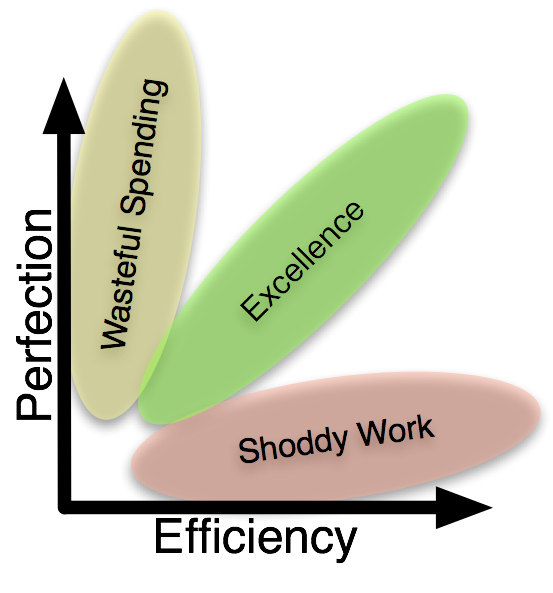
I use to work for an organization that put a lot of emphasis on “excellence”. This sounds like a good thing, but it was very poorly defined and tended to become an excuse for wreaking mayhem with the budget. Spending 100% more for a 10% gain toward perfection didn’t seem like what I would define as excellence.
As I thought I about it, I realized the the problem stemmed from equating excellence with perfection. Excellence is actually made up of more than one dimension. Perfection is one of those dimensions, but you must have another dimension that recognizes we are dealing with finite resources. Usually this is best represented as cost in monetary terms, but it could also represent time and how efficiently we convert that time or money into perfection. This chart shows how the two dimensions together represent excellence.

If you achieve perfection without any control of the expense, you will end up with waste. This takes you out of the green excellence zone. If you only focus on keeping your costs down without any focus on perfection, you will produce shoddy work.
Excellence comes from balancing efficiency with perfection. Basically it comes down to doing the best with what you are given. If you are given a million dollar budget for a project, the amount of perfection should reflect the large investment. If you are given $10,000 for a project, you should still be able to stay in the green zone by making the most efficient use of your resources as possible.
Taking the time to reflect on your work and determining which zone your results belong in can be a valuable exercise.
Here are some questions to ask yourself about your current projects:
- If I cut costs by 25% how much will it hurt the project? If cutting costs by 25% would have a minimal impact on the project, you may be operating in the waste zone.
- If I were to increase spending (time or money) by 10% would it result in a better end result? If the end result is 200% better, you may want to try to allocate additional resources or funds to the project.
- Can I get a better product without spending more? Most projects have a certain amount of unnecessary waste. If you can trim that part and apply it toward other areas, you may be able to increase the excellence without actually spending any more time or money.
Nice post! I wonder if there is more to excellence than just Efficiency and perfection. If there are more aspects to excellence perhaps the graph will change. The aspects would create a cone shape with excellence as the focus. Like a satellite.
This reminds me of something a friend once had in his .sig:
You can have it done fast |
You can have it done cheap | <- Pick any two
You can have it done right |
Thanks for the excellent reminder that excellence doesn’t necessarily mean perfection. It made me think of a job I had many years when the agency was running a “zero defects” campaign. One of my co-workers said, “Heck, if I had zero defects, I’d be up in heaven tinklin’ them little bells!”
@Michael – I’m sure there are many other dimensions as well. For example, a gold septic tank probably doesn’t make sense even if it is reasonably inexpensive. It a lot of ways those other dimensions come down to expense in the sense of time though, so I think the two dimensions cover the most important parts.
@techne – I’ve seen that many times. It is amazing how accurate it is. :)
@Lillie – Nice quote. :) I’m not against striving for perfection. I’m against doing it without any thought to the cost.
Right on!!!! Love the visual!!!
Great job! I really appreciate the work you put into this and especially the graphic. Now, if only there was a similar definition of, “Best Practice”. I used to work in an organization where ‘best practice’ was used by management to direct changes without having to give an intelligent reason for doing so. The term was used differently for all situations, so there really wasn’t a way to grasp the concept. I have an idea what it should be, but my reasoning and their use of the concept never intersected.
Thank you again!
@Dan – In places I’ve worked, anyone who said something was “Best Practice” had to tell why it was best practice. Often it was just because it was a standardized way of doing things. Sometimes it meant that the lawyers had said it was the course of action least likely to result in a lawsuit. Sometimes it was based on a focus group that had researched the problem several months earlier. However, it was expected that “Best Practice” actually had some type of thought behind it.
@ Mark – Those would be the idea methods to incorporate a “Best Practice” philosophy; however, that’s the not case in state government (at least in the department I worked for in Tennessee state government). Needless to say, anytime I asked why something was considered Best Practice I received a certain look (if you know what I mean). It always struck me how Best Practice never seemed to make its way into policy and procedure. It was a way to duck and dodge those areas. I always wondered how legal counsel within the department would have evaluated our Best Practices with all the court settlements and other court cases which had determined our policies to begin with. Thanks Mark!
Thank you for this article. The margin between perfection and excellence is very slim in terms of achievement, but very very wide in terms of effort and time. You helped me a great deal in my current work and mind set.
Hard to read an article on perfection when the second word is spelled wrong and used in the wrong tense. Sorry
Thanks for the suggestion. But it sounds like you missed the entire point of the article.